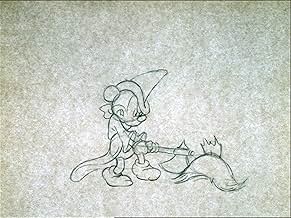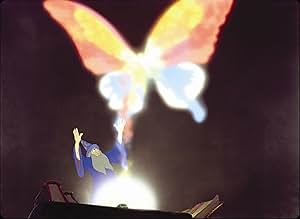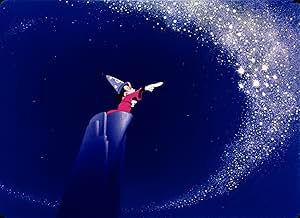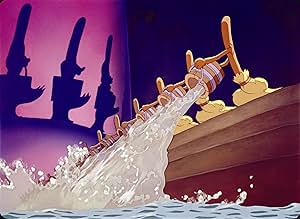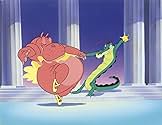CALIFICACIÓN DE IMDb
7.7/10
108 k
TU CALIFICACIÓN
Una colección de interpretaciones animadas de grandes obras de música clásica occidental.Una colección de interpretaciones animadas de grandes obras de música clásica occidental.Una colección de interpretaciones animadas de grandes obras de música clásica occidental.
- Premios
- 9 premios ganados y 1 nominación en total
Corey Burton
- Narrator: Deems Taylor overdubs (2000 restoration)
- (voz)
- (sin créditos)
Walt Disney
- Mickey Mouse (segment 'The Sorcerer's Apprentice')
- (voz)
- (sin créditos)
Hugh Douglas
- Narrator (1982 version)
- (voz)
- (sin créditos)
James MacDonald
- Percussionist
- (sin créditos)
Tim Matheson
- Narrator (1985 version)
- (voz)
- (sin créditos)
Julietta Novis
- Soloist (segment 'Ave Maria')
- (doblaje en canto)
- (sin créditos)
Paul J. Smith
- Violinist
- (sin créditos)
Opiniones destacadas
Fantasia is so educational, and I was gob smacked by how well the animation mixed with the classical music. Can I also say that Leopold Stokowski is one of the best conductor of the 20th century, right on a parallel with Herbert Von Karajan? I was listening to Sibelius's 5th symphony a few years back, and he conducted it the year before he died, and he was in his 90s. Not only that, but that was the best version of that symphony I had ever heard. Back to Fantasia then. Each piece was expertly introduced by Deems Taylor, and unlike its sequel didn't take too long.(Even the soundtrack vignette was interesting) In the sequel, almost half of the film felt like too much introduction and not enough music. Fantasia rectified that problem brilliantly:
1. Bach's Toccata- Brilliant silhouettes of the orchestra, and then masterful abstract images. The orchestra played the piece to a phenomenal standard, and I hate to say this, but I actually prefer the piece orchestrated. It was originally written for organ, you see. The best thing about Stokowski is that you see him conducting without a baton, which is exceedingly clever.
2. Tchaikovsky's Nutcracker- I recommend you see the ballet, because it is a knockout. This is coming from a classical music lover. The animation was superb in this vignette. The most impressive thing though was the fact that the finishes immediately went into the next scene, without it being hackneyed. The waltz, or Dance of the Snow Fairies, was the highlight of this vignette, reminding me so strongly of Christmas.
3. Dukas's Scorceror's Apprentice- The most famous vignette, is the only vignette to feature in the sequel. YenSid(Disney backwards) has a magic hat, which he leaves lying around, and Mickey Mouse picks it up, and encounters various problems. the animation is very good here, and while I'm not a huge fan of the piece, I still found it enjoyable.
4. Stravinsky's Rite of Spring- This is the only reason why the movie isn't a 10. This vignette is far too long It's longer than the Beethoven. It is an interesting subject, dinosaurs, but the ballet wasn't simplified enough. This was boring, and was better left out. It was only here to give some historical context. However, there was beautiful animation and some lovely instrumental solos. Stravinsky hated what the film did to his work, but anyway I don't like Stravinsky much. I had no problem with the animation or the way it was performed, it was just too long.
5. Beethoven's pastoral Symphony- This is a fantastic piece of music. I am a huge fan of Beethoven, and I have all his 9 symphonies on my IPod. My favourites are this, the Choral and the Eroica. I loved the fact that they chose a Greek mythological setting, because it looked gorgeous. My dad who is a conductor wasn't keen on the centaurs, but I loved the winged horses, Bacchus and Zeus (who competes with Chernabog as the most frightening character of the movie). This vignette was so relaxing to watch; think it as like reciting a poem.
6. Ponchielli's Dance of the Hours-This was the funniest vignette of the film, and one of the many gems of Disney. It was a bit unrealistic of course, but it was fun. At first, I was worried that the most famous scene from the opera La Giaconda, would be ruined by the animation. But it wasn't. It was perfect. Even the elephants and hippos, considering their size, danced so elegantly, I was shocked. This vignette is a must-see if you want some comedy.
7. Mussorgsky's Night on Bare Mountain- Now this was my personal favourite, as when I first watched it when I was 10, and I was terrified of Chernabog. The music is also very hard to play, as the mood is very hard to capture, but this is undoubtedly the finest recording of this music. Chernabog was genuinely frightening, and a masterful creation. And the animation, while dark, matched the music, which is enough to give you nightmares, flawlessly. It was very like a Witch's Sabbath, which was what the composer originally intended. Do you know, that for his underrated fantasy movie Legend, Ridley Scott based Tim Curry's Darkness on Chernabog? Children may find it a bit too frightening, and adults may find it inappropriate, as there is a tiny glimpse of nudity. But it was still an effective vignette, and one of my favourite Disney moments actually.
8. Schubert's Ave Maria- This is a beautiful song, and Stokowski did it justice. The harmonies and animation were perfectly captured. how could you say this was boring? The animation couldn't have been happy looking, it would have completely ruined the mood of the song. It was beautifully sung by Juillietta Novis, who was so quiet that you had to turn the volume up, but that was the intention. The thing that impressed me most, was the complete contrast of this from the Mussorgsky, so the key of Ave Maria was so well chosen. (It is sung in many different keys.) In conclusion, the most underrated of the earlier Disney efforts, is well worth watching and a true animated classic! Also I was offended by the review that said that it was the worst movie ever made, and that the people who love this movie need new taste, that is plain insulting to anyone who grew up with this film. 9/10 Bethany Cox.
1. Bach's Toccata- Brilliant silhouettes of the orchestra, and then masterful abstract images. The orchestra played the piece to a phenomenal standard, and I hate to say this, but I actually prefer the piece orchestrated. It was originally written for organ, you see. The best thing about Stokowski is that you see him conducting without a baton, which is exceedingly clever.
2. Tchaikovsky's Nutcracker- I recommend you see the ballet, because it is a knockout. This is coming from a classical music lover. The animation was superb in this vignette. The most impressive thing though was the fact that the finishes immediately went into the next scene, without it being hackneyed. The waltz, or Dance of the Snow Fairies, was the highlight of this vignette, reminding me so strongly of Christmas.
3. Dukas's Scorceror's Apprentice- The most famous vignette, is the only vignette to feature in the sequel. YenSid(Disney backwards) has a magic hat, which he leaves lying around, and Mickey Mouse picks it up, and encounters various problems. the animation is very good here, and while I'm not a huge fan of the piece, I still found it enjoyable.
4. Stravinsky's Rite of Spring- This is the only reason why the movie isn't a 10. This vignette is far too long It's longer than the Beethoven. It is an interesting subject, dinosaurs, but the ballet wasn't simplified enough. This was boring, and was better left out. It was only here to give some historical context. However, there was beautiful animation and some lovely instrumental solos. Stravinsky hated what the film did to his work, but anyway I don't like Stravinsky much. I had no problem with the animation or the way it was performed, it was just too long.
5. Beethoven's pastoral Symphony- This is a fantastic piece of music. I am a huge fan of Beethoven, and I have all his 9 symphonies on my IPod. My favourites are this, the Choral and the Eroica. I loved the fact that they chose a Greek mythological setting, because it looked gorgeous. My dad who is a conductor wasn't keen on the centaurs, but I loved the winged horses, Bacchus and Zeus (who competes with Chernabog as the most frightening character of the movie). This vignette was so relaxing to watch; think it as like reciting a poem.
6. Ponchielli's Dance of the Hours-This was the funniest vignette of the film, and one of the many gems of Disney. It was a bit unrealistic of course, but it was fun. At first, I was worried that the most famous scene from the opera La Giaconda, would be ruined by the animation. But it wasn't. It was perfect. Even the elephants and hippos, considering their size, danced so elegantly, I was shocked. This vignette is a must-see if you want some comedy.
7. Mussorgsky's Night on Bare Mountain- Now this was my personal favourite, as when I first watched it when I was 10, and I was terrified of Chernabog. The music is also very hard to play, as the mood is very hard to capture, but this is undoubtedly the finest recording of this music. Chernabog was genuinely frightening, and a masterful creation. And the animation, while dark, matched the music, which is enough to give you nightmares, flawlessly. It was very like a Witch's Sabbath, which was what the composer originally intended. Do you know, that for his underrated fantasy movie Legend, Ridley Scott based Tim Curry's Darkness on Chernabog? Children may find it a bit too frightening, and adults may find it inappropriate, as there is a tiny glimpse of nudity. But it was still an effective vignette, and one of my favourite Disney moments actually.
8. Schubert's Ave Maria- This is a beautiful song, and Stokowski did it justice. The harmonies and animation were perfectly captured. how could you say this was boring? The animation couldn't have been happy looking, it would have completely ruined the mood of the song. It was beautifully sung by Juillietta Novis, who was so quiet that you had to turn the volume up, but that was the intention. The thing that impressed me most, was the complete contrast of this from the Mussorgsky, so the key of Ave Maria was so well chosen. (It is sung in many different keys.) In conclusion, the most underrated of the earlier Disney efforts, is well worth watching and a true animated classic! Also I was offended by the review that said that it was the worst movie ever made, and that the people who love this movie need new taste, that is plain insulting to anyone who grew up with this film. 9/10 Bethany Cox.
This unusual and very creative classic of animation combines a very interesting idea with quite a bit of imagination, plus visual effects that still hold up quite well. All but a couple of the sequences are quite enjoyable, and some especially so. Even the segments that don't work as well are usually at least interesting, since you can at least appreciate what they were trying to accomplish.
You don't really have to be all that familiar with the specific pieces of music for it to be worthwhile, since in several cases they chose to match the music with material that is rather different in nature from any original context that it may have had. And in any case, the animated sequences are intended to provide the context, in terms of the movie.
No doubt, everyone will have his or her own favorite segments, based on the music itself and on the choice of accompanying visual material. The "Sorcerer's Apprentice" sequence, with Mickey Mouse, is certainly one of the most memorable. The adaptation of "The Rite of Spring" is quite imaginative in using an entirely different setting for the music. "Night on Bald Mountain" has striking and sometimes bizarre visuals.
Many of the classic Disney features still hold up well as family entertainment, but "Fantasia" is unique for its combination of imaginative concept and visual creativity. Not every minute of it works, but that's the price of being willing to experiment. It's an enjoyable and satisfying feature that well deserves to be remembered.
You don't really have to be all that familiar with the specific pieces of music for it to be worthwhile, since in several cases they chose to match the music with material that is rather different in nature from any original context that it may have had. And in any case, the animated sequences are intended to provide the context, in terms of the movie.
No doubt, everyone will have his or her own favorite segments, based on the music itself and on the choice of accompanying visual material. The "Sorcerer's Apprentice" sequence, with Mickey Mouse, is certainly one of the most memorable. The adaptation of "The Rite of Spring" is quite imaginative in using an entirely different setting for the music. "Night on Bald Mountain" has striking and sometimes bizarre visuals.
Many of the classic Disney features still hold up well as family entertainment, but "Fantasia" is unique for its combination of imaginative concept and visual creativity. Not every minute of it works, but that's the price of being willing to experiment. It's an enjoyable and satisfying feature that well deserves to be remembered.
This without a doubt the greatest animated film in history. While highly acclaimed and well-known today, it was not terribly popular when it was first released. The idea of "Fantasia" is to take great pieces of music and draw animated sequences that match them. In doing so, it reverses the purpose of a movie's score; the movie serves and matches the music, not the other way around. This set up also means that there is no typical formula plot that is present in the vast majority of movies. In the first piece, the animation is vague and abstract, but in later ones it is of definite actions, objects, and stories. The two most famous(and my favorite) parts are probably "The Sorcerer's Apprentice" and "Rite of Spring". "Fantasia" is not only the best animated film ever made, but one of the greatest films period.
2017 is a year of technical marvel. Looking at movies of today, we see massive, stunning works of animation. We can now achieve computer generated images that look nearly indistinguishable from reality, and at the forefront of movie making today is Disney. Through Marvel, Disney creates multiple action packed superhero blockbusters a year. Star Wars, after it's 2015 revival, has new movies being released annually. Pixar, after creating several successful franchises, is now resting on its laurels, creating sequels like Finding Dory, Toy Story 4, Cars 3 and Incredibles 2. Even Disney's in house animation team is finding success, bringing back the Disney princess formula with movies like Frozen and Moana. However, amidst all this success, we have lost the truly human touch. Fantasia perfectly captures all that was lost in today's Disney movies. The movie has a very personal and human feel to every aspect of it. The orchestra, a very tangible presence in the movie, feels alive. They laugh, play their own little tunes during the intermission, but most importantly, they make mistakes. The animation is the same way, It's very rough at times and sometimes lacking, with some animations being reused, however every shot is filled with passion. You can tell that people worked on this, people with ambition, though they were not perfect. In modern movies, this beautiful animation that looks so real lacks the touch of individualism that Fantasia has in spades. The scene of the Sorcerer's apprentice dancing around the broom is burned into our collective memory for a reason. In all its flaws, its rough edges, it feels real to us. We can see all the raw effort and energy that the animator's put into each of Mickey's footsteps and that resonates with us. Fantasia speaks to the viewer not because it's perfect, but because it's flawed.
I first remember hearing about this movie when I was very little, and ever since I first watched it on VHS, it has always been one of the many examples of my favorite movies of all time. This is so unique, because unlike a typical Disney movie, in this movie we do not hear any dialog from the characters, and all of the music is instrumental (except for "Ave Maria" at the end). The film is divided into eight sequences, each of them being introduced by a guy named Deems Taylor, who was a very well-known music critique.
The eight segments are as follows:
1.) "Tocatta & Fugue in D-minor" composed by Johanne Sebastian Bach. This segment consists of shots of the Philadelphia Orchestra and their conductor Leopold Stokowski with a lot of cool shadow and color effects during the first three minutes, then we see a lot of shapes and random objects that Taylor would suggest to us might pop into our brains when listening to the music.
2.) "The Nutcracker Suite" composed by Tchaikovsky. In this part of the movie, we listen to excerpts of the famous ballet suite, and we see various fairies, flowers, fish and other nature-related creatures.
3.) Everyone's favorite "The Sorcerer's Apprentice" starring Sorcerer Mickey and Yen Sid (the sorcerer whose name is "Disney" spelled backwards). This is also the only segment to be seen again in this film's sequel, "Fantasia/2000" 60 years later, and in it the apprentice brings to life a magical broomstick to try to fill a cauldron with water, and the spell goes wrong so the apprentice gets reprimanded. This is then followed by Mickey greeting conductor Stokowski.
4.) "Rite of Spring" composed by Igor Stravinsky. This segment takes place billions and billions of years ago with the coming of the dinosaurs, where we see the creation of Earth in the beginning of time, and are later introduced to all of the different dinosaurs including the tyrannosaurus rex, which become extinct in the end of the segment.
5.) "Intermission/Meet the Soundtrack". At this point in the film, Deems Taylor introduces this string thingamajigger called the "Soundtrack" that he asks to make a lot of sounds resembling various instrument sounds.
6.) "Pastoral Symphony No. 6" composed by Beethoven. This segment is about a day in the countryside, and in it we see a lot of Greek mythology creatures like unicorns, satyrs, centaurs and centaurettes, cupids, Bacchus, Zeus, Iris, Apollo and Diana.
7.) "Dance of the Hours". This is where we see dancing ostriches, alligators, elephants and hippos. Each part of the piece suggests different hours of the day, and it all ends with a triumphant finale where the dancing hippo takes center stage.
8.) A combination of two pieces that are utterly different in mood and tone. They are "Night on Bald Mountain" in which a bat villain named Chernabog has Satan's evil spirits dance furiously until the coming of the sacred dawn, and then Franz Schubert's "Ave Maria" which is the one and only part of the whole film in which we hear lyrics sung, and then the movie ends.
I simply must say that not only is this film one of my all time favorite animated masterpieces, but it is also an example of a big highlight of the 1940's in cinematic history, all because of the ways it is so unique and special. In addition to this masterpiece, I also think "The Wizard of Oz", "Gone with the Wind", "Citizen Kane" and "Casablanca" are main icons of cinematic successes. I definitely think this should have been the first animated movie to be nominated for the Best Picture Academy Award instead of "Beauty and the Beast".
The eight segments are as follows:
1.) "Tocatta & Fugue in D-minor" composed by Johanne Sebastian Bach. This segment consists of shots of the Philadelphia Orchestra and their conductor Leopold Stokowski with a lot of cool shadow and color effects during the first three minutes, then we see a lot of shapes and random objects that Taylor would suggest to us might pop into our brains when listening to the music.
2.) "The Nutcracker Suite" composed by Tchaikovsky. In this part of the movie, we listen to excerpts of the famous ballet suite, and we see various fairies, flowers, fish and other nature-related creatures.
3.) Everyone's favorite "The Sorcerer's Apprentice" starring Sorcerer Mickey and Yen Sid (the sorcerer whose name is "Disney" spelled backwards). This is also the only segment to be seen again in this film's sequel, "Fantasia/2000" 60 years later, and in it the apprentice brings to life a magical broomstick to try to fill a cauldron with water, and the spell goes wrong so the apprentice gets reprimanded. This is then followed by Mickey greeting conductor Stokowski.
4.) "Rite of Spring" composed by Igor Stravinsky. This segment takes place billions and billions of years ago with the coming of the dinosaurs, where we see the creation of Earth in the beginning of time, and are later introduced to all of the different dinosaurs including the tyrannosaurus rex, which become extinct in the end of the segment.
5.) "Intermission/Meet the Soundtrack". At this point in the film, Deems Taylor introduces this string thingamajigger called the "Soundtrack" that he asks to make a lot of sounds resembling various instrument sounds.
6.) "Pastoral Symphony No. 6" composed by Beethoven. This segment is about a day in the countryside, and in it we see a lot of Greek mythology creatures like unicorns, satyrs, centaurs and centaurettes, cupids, Bacchus, Zeus, Iris, Apollo and Diana.
7.) "Dance of the Hours". This is where we see dancing ostriches, alligators, elephants and hippos. Each part of the piece suggests different hours of the day, and it all ends with a triumphant finale where the dancing hippo takes center stage.
8.) A combination of two pieces that are utterly different in mood and tone. They are "Night on Bald Mountain" in which a bat villain named Chernabog has Satan's evil spirits dance furiously until the coming of the sacred dawn, and then Franz Schubert's "Ave Maria" which is the one and only part of the whole film in which we hear lyrics sung, and then the movie ends.
I simply must say that not only is this film one of my all time favorite animated masterpieces, but it is also an example of a big highlight of the 1940's in cinematic history, all because of the ways it is so unique and special. In addition to this masterpiece, I also think "The Wizard of Oz", "Gone with the Wind", "Citizen Kane" and "Casablanca" are main icons of cinematic successes. I definitely think this should have been the first animated movie to be nominated for the Best Picture Academy Award instead of "Beauty and the Beast".
¿Sabías que…?
- TriviaDuring production, the animators were given no instructions for coloring. Walt Disney instructed them to use any colors they wanted, which was a first.
- ErroresWhen introducing the "Pastoral" sequence, Deems Taylor mixes Greek and Roman names of deities: Bacchus, Vulcan and Diana are Roman; Zeus, Iris and Morpheus are Greek. Apollo is the only one whose Greek and Roman equivalents have the same name.
- Citas
Mickey Mouse: [Pulling on Stokowski's coat] Mr. Stokowski! Mr. Stokowski!
[Mickey whistles to get Stokowski's attention]
Mickey Mouse: My congratulations, sir!
Leopold Stokowski: [shaking hands with Mickey] Congratulations to you, Mickey!
Mickey Mouse: Gee, thanks! Hehe! Well, so long! I'll be seeing ya!
Leopold Stokowski: Goodbye!
- Créditos curiososThere are no closing credits of any kind. Not even the words "THE END" appear on the screen.
- Versiones alternativasBefore the 1990 re-release, the film was shown with no credits other than the title and the RKO logo. Leopold Stokowski received a written credit only on the posters advertising the film. In the film's original roadshow release, not even the title was shown at the beginning of the film - that was saved for the intermission break.
- ConexionesEdited into A World Is Born (1955)
- Bandas sonorasToccata and Fugue in D Minor, BWV 565
Composed by Johann Sebastian Bach
Orchestrated by Leopold Stokowski (uncredited)
Played by The Philadelphia Orchestra
Conducted by Leopold Stokowski
Selecciones populares
Inicia sesión para calificar y agrega a la lista de videos para obtener recomendaciones personalizadas
Detalles
Taquilla
- Presupuesto
- USD 2,280,000 (estimado)
- Total en EE. UU. y Canadá
- USD 76,408,097
- Fin de semana de estreno en EE. UU. y Canadá
- USD 980,798
- 10 feb 1985
- Total a nivel mundial
- USD 76,412,966
- Tiempo de ejecución2 horas 4 minutos
- Color
- Mezcla de sonido
- Relación de aspecto
- 1.37 : 1
Contribuir a esta página
Sugiere una edición o agrega el contenido que falta

Principales brechas de datos
By what name was Fantasía (1940) officially released in India in Hindi?
Responda




